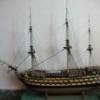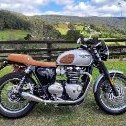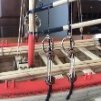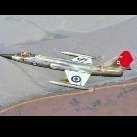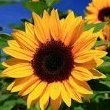MORE HANDBOOKS ARE ON THEIR WAY! We will let you know when they get here.
×
-
Posts
4,564 -
Joined
-
Last visited
Reputation Activity
-
 Blue Ensign got a reaction from mtaylor in Chris Watton and Vanguard Models news and updates
Blue Ensign got a reaction from mtaylor in Chris Watton and Vanguard Models news and updates
Happy Birthday Chris, have a great day.
Just enjoying the thought of what wonders you will produce in the next 20 years
Regards,
Maurice (B.E.)
-
 Blue Ensign got a reaction from Gahm in HMS Sphinx 1775 by Hollowneck - FINISHED - Vanguard Models - 1:64
Blue Ensign got a reaction from Gahm in HMS Sphinx 1775 by Hollowneck - FINISHED - Vanguard Models - 1:64
I think you have the shape spot on Ron, looks very convincing.
A modification you could add is to paint the English Cross of St George in the Hoist section.
These were the four commission pennants of the period.
Colours of the Red, White, and Blue squadrons, and the Union (Common) pennant as an alternative.
Red and blue (up to 1864), Common (up to 1850). The White remained in use post 1864 as the designated naval colour.
Regards,
B.E.
-
 Blue Ensign got a reaction from hollowneck in Chris Watton and Vanguard Models news and updates
Blue Ensign got a reaction from hollowneck in Chris Watton and Vanguard Models news and updates
Happy Birthday Chris, have a great day.
Just enjoying the thought of what wonders you will produce in the next 20 years
Regards,
Maurice (B.E.)
-
 Blue Ensign got a reaction from DB789 in Chris Watton and Vanguard Models news and updates
Blue Ensign got a reaction from DB789 in Chris Watton and Vanguard Models news and updates
Happy Birthday Chris, have a great day.
Just enjoying the thought of what wonders you will produce in the next 20 years
Regards,
Maurice (B.E.)
-
 Blue Ensign got a reaction from thibaultron in Chris Watton and Vanguard Models news and updates
Blue Ensign got a reaction from thibaultron in Chris Watton and Vanguard Models news and updates
Happy Birthday Chris, have a great day.
Just enjoying the thought of what wonders you will produce in the next 20 years
Regards,
Maurice (B.E.)
-
 Blue Ensign reacted to chris watton in Chris Watton and Vanguard Models news and updates
Blue Ensign reacted to chris watton in Chris Watton and Vanguard Models news and updates
Thank you, Kevin! Yep, 56 now, so probably have at least another 20 years of doing kits, all being well...
-
 Blue Ensign got a reaction from shipman in 36 Foot Admirals Barge by Blue Ensign – FINISHED - Vanguard Models – 1:64 scale
Blue Ensign got a reaction from shipman in 36 Foot Admirals Barge by Blue Ensign – FINISHED - Vanguard Models – 1:64 scale
Post Ten
Internal fittings are now removed for test fitting.
The thwarts are an integrated unit combining the central Longitudinal plank. This is typical of barges of this period.
9440
The stern benches are also a single unit that look to require only minimal adjustment to fit.
Before they are fitted the seat stanchions that run down the centre of the footwaling are required to be fitted.
Section 38 of the blurb refers to the fitting but does not mention that the stanchions are of brass etch.
9438
They are numbered sequentially on the blurb and a careful check of the etch shows that the ten stanchions are position specific, fore, and aft to accommodate the sheer.
They are not however, numbered as per Section 38 of the blurb.
The way the kit is set up the stanchions dictate the height of the thwarts, and the hull ribs will need reducing in height where they impact on the thwart ends.
I decided to use the etch supports partly because I felt they gave the best chance of getting the thwart height correct.
9467
9465
The biro gives the relative size of the barge.
9470
I was still keen to check that the thwart height was correct.
9469
Unlike the usual practice of risers along the internal hull to support the thwarts, this kit relies on the central columns and the ribs cut to suit for support.
9468
With the scale figures in place, I am pleased to see that the height is good. It is also clear why barges of this era were rowed single banked.
My use of ‘test’ thwarts has given me the line for the risers, and I don’t really understand why they haven’t been employed on this kit.
48Bb(2)
Once the thwarts and benches are in place small wooden block panels are fitted between the thwarts along hull.
This is a simplification of the proper arrangement, perhaps understandable given the scale, but it does look a tad unconvincing to my eye.
The inner hull should be lined over the ribs and decorative mouldings applied.
I have an idea of how to do this from my Model Shipways Pinnace build, but that was at 1:24 scale.
Before I admit abject defeat, I will have a play around and see what can be done.
B.E.
20/11/2022
-
 Blue Ensign got a reaction from mtaylor in HMS Sphinx 1775 by Hollowneck - FINISHED - Vanguard Models - 1:64
Blue Ensign got a reaction from mtaylor in HMS Sphinx 1775 by Hollowneck - FINISHED - Vanguard Models - 1:64
I think you have the shape spot on Ron, looks very convincing.
A modification you could add is to paint the English Cross of St George in the Hoist section.
These were the four commission pennants of the period.
Colours of the Red, White, and Blue squadrons, and the Union (Common) pennant as an alternative.
Red and blue (up to 1864), Common (up to 1850). The White remained in use post 1864 as the designated naval colour.
Regards,
B.E.
-
 Blue Ensign reacted to Beef Wellington in HMS Jason by Beef Wellington - Caldercraft - 1:64 - Artois-class frigate modified from HMS Diana 1794
Blue Ensign reacted to Beef Wellington in HMS Jason by Beef Wellington - Caldercraft - 1:64 - Artois-class frigate modified from HMS Diana 1794
@Wayne - I miss seeing progress on your Enterprise, hopefully soon (?) That will be a beauty!
@Mark - I aspire to be able to do what your are achieving on your excellent Le Rochefort build, would love to do a POF one one day and I need to bone up on basic woodworking techniques first.
Quarterdeck plansheer (capping rail?):
Work can now commence on the quarterdeck plansheer given that the upper hull profile is finalised. This will be a rather long process given the many breaks in the smooth run of the plansheer. Starting with the quarterdeck, a 'lego' type approach was taken to build items individually and then combine on the hull. While more time consuming (what does that matter!), my feeling was that it would give more control over the outcome. 3 pieces will be needed, and will be referred to rather unimaginatively as pieces 1,2 and 3 becuase I have no idea how better to refer to them. (Given that 2D plans don't seem to translate 3D, I have attempted to study as many pictures of contemporary models, plans and the many high quality builds here - all I could really glean was that there are many ways to approach this, and this approach is probably a compromise.). This is the area I'm talking about:
Piece #1: from the gunwale, around the main drift volute to the terminaton of the scroll decoration (yellow) Piece #2: middle section with a scroll type detail on one end (green) Piece #3: section following the profile caused by the break of the quarterdeck drift rail to the main rail (red) Construction of Piece #1:
Without anythig sufficient thick to hand, 4mm pear sheet wood was laminated together and ever increasing holes drilled until 6mm had been achieved (curvature of volute top). A hand drill had to be used for this as I don't have a drill press. Care was taken to ensure that the grain was running perpendicular to the hole which I suspect will give the strongest final result. The hole was then very carefully reduced on the circular sander until just before the hole was opened up. (I managed to do this on both sides which allowed 2 sections to be made from one hole). 1mm thick strips were then attached on each side, with PVA glue only being used on one side and clamped. Once thoroughly dry, the piece was roughly shaped toward its final form of a 1mm thick curve. The part was cut in half, releasing each curved section for final finishing using sanding sticks. (Note: the downside of only having a hand drill means it is very difficult to get perpendicular holes, and the top block shows a failure to allow for this).
Construction of Piece #2:
The scroll detail is probably the most complicated item to deal with. To start, sandpaper wrapped around a section of 6mm dowel and a curved profile introduced into some 4mm cherry sheet. The section was then temporarily glued to some scrap to allow the excess material to be carefully removed on the circular sander, (a technique that is becoming very familiar!). The two halves were detatched, and glued to a pre-shaped section of 1.5mm thick pear because the curve of the hull is a factor. The first photo below shows this starting point from which the final form was shaped. The second photo shows progress mid way through shaping. To account for the scroll detail, a circular needle file was used to introduce a profile into which some pre-made 1.5mm pear dowel could be glued.
Construction of Piece #3:
This was constructed in exactly the same way as piece #1, only difference being that 1.5mm was used for the plansheer.
Once each step was completed, the pieces can the be individually fine tuned prior to installation, each having deliberately been made a little long. A profile was introduced in the usual fashion using a profile cut into a safety razor blade (see final pics below):
The curved sections proved not unexpectedly to be the most challenging to fine tune. The aft end of piece #3 terminates in a gun port which would be relatively easy to finish when the time comes, so this was fitted fitted first. The most worrying thing here was coping the angle of the curved portion to tie into the aft end of piece #2 to avoid a time intensive redo (65deg was found to be the solution). Piece #2 was then very carefully shortened until it sat correctly. Before piece #1 could be finalized, the gunwale was made up to ensure correct positioning and shaping as piece #1 will butt up against both.
And the results...
Everything is dryfit only for now. Pins were used to temporarily hold the various sections in place, these can be easily filled, although efforts were made to place these where the timber heads will cover them. With the exception of the gunwale, the plansheer sections have not yet been painted but have been coloured with artist pens to help my eye determine final proportions. The final shot below shows how even the relatively minor curve of the hull at this point needs to be accounted for. I have a lot of work ahead of me to finish off the other areas so will likely be a while before another update, but must confess to be being very pleased with the way this turned out.
-
 Blue Ensign got a reaction from Knocklouder in 36 Foot Admirals Barge by Blue Ensign – FINISHED - Vanguard Models – 1:64 scale
Blue Ensign got a reaction from Knocklouder in 36 Foot Admirals Barge by Blue Ensign – FINISHED - Vanguard Models – 1:64 scale
Post Ten
Internal fittings are now removed for test fitting.
The thwarts are an integrated unit combining the central Longitudinal plank. This is typical of barges of this period.
9440
The stern benches are also a single unit that look to require only minimal adjustment to fit.
Before they are fitted the seat stanchions that run down the centre of the footwaling are required to be fitted.
Section 38 of the blurb refers to the fitting but does not mention that the stanchions are of brass etch.
9438
They are numbered sequentially on the blurb and a careful check of the etch shows that the ten stanchions are position specific, fore, and aft to accommodate the sheer.
They are not however, numbered as per Section 38 of the blurb.
The way the kit is set up the stanchions dictate the height of the thwarts, and the hull ribs will need reducing in height where they impact on the thwart ends.
I decided to use the etch supports partly because I felt they gave the best chance of getting the thwart height correct.
9467
9465
The biro gives the relative size of the barge.
9470
I was still keen to check that the thwart height was correct.
9469
Unlike the usual practice of risers along the internal hull to support the thwarts, this kit relies on the central columns and the ribs cut to suit for support.
9468
With the scale figures in place, I am pleased to see that the height is good. It is also clear why barges of this era were rowed single banked.
My use of ‘test’ thwarts has given me the line for the risers, and I don’t really understand why they haven’t been employed on this kit.
48Bb(2)
Once the thwarts and benches are in place small wooden block panels are fitted between the thwarts along hull.
This is a simplification of the proper arrangement, perhaps understandable given the scale, but it does look a tad unconvincing to my eye.
The inner hull should be lined over the ribs and decorative mouldings applied.
I have an idea of how to do this from my Model Shipways Pinnace build, but that was at 1:24 scale.
Before I admit abject defeat, I will have a play around and see what can be done.
B.E.
20/11/2022
-
 Blue Ensign got a reaction from gjdale in 36 Foot Admirals Barge by Blue Ensign – FINISHED - Vanguard Models – 1:64 scale
Blue Ensign got a reaction from gjdale in 36 Foot Admirals Barge by Blue Ensign – FINISHED - Vanguard Models – 1:64 scale
Post Ten
Internal fittings are now removed for test fitting.
The thwarts are an integrated unit combining the central Longitudinal plank. This is typical of barges of this period.
9440
The stern benches are also a single unit that look to require only minimal adjustment to fit.
Before they are fitted the seat stanchions that run down the centre of the footwaling are required to be fitted.
Section 38 of the blurb refers to the fitting but does not mention that the stanchions are of brass etch.
9438
They are numbered sequentially on the blurb and a careful check of the etch shows that the ten stanchions are position specific, fore, and aft to accommodate the sheer.
They are not however, numbered as per Section 38 of the blurb.
The way the kit is set up the stanchions dictate the height of the thwarts, and the hull ribs will need reducing in height where they impact on the thwart ends.
I decided to use the etch supports partly because I felt they gave the best chance of getting the thwart height correct.
9467
9465
The biro gives the relative size of the barge.
9470
I was still keen to check that the thwart height was correct.
9469
Unlike the usual practice of risers along the internal hull to support the thwarts, this kit relies on the central columns and the ribs cut to suit for support.
9468
With the scale figures in place, I am pleased to see that the height is good. It is also clear why barges of this era were rowed single banked.
My use of ‘test’ thwarts has given me the line for the risers, and I don’t really understand why they haven’t been employed on this kit.
48Bb(2)
Once the thwarts and benches are in place small wooden block panels are fitted between the thwarts along hull.
This is a simplification of the proper arrangement, perhaps understandable given the scale, but it does look a tad unconvincing to my eye.
The inner hull should be lined over the ribs and decorative mouldings applied.
I have an idea of how to do this from my Model Shipways Pinnace build, but that was at 1:24 scale.
Before I admit abject defeat, I will have a play around and see what can be done.
B.E.
20/11/2022
-
 Blue Ensign got a reaction from Ryland Craze in 36 Foot Admirals Barge by Blue Ensign – FINISHED - Vanguard Models – 1:64 scale
Blue Ensign got a reaction from Ryland Craze in 36 Foot Admirals Barge by Blue Ensign – FINISHED - Vanguard Models – 1:64 scale
Post Ten
Internal fittings are now removed for test fitting.
The thwarts are an integrated unit combining the central Longitudinal plank. This is typical of barges of this period.
9440
The stern benches are also a single unit that look to require only minimal adjustment to fit.
Before they are fitted the seat stanchions that run down the centre of the footwaling are required to be fitted.
Section 38 of the blurb refers to the fitting but does not mention that the stanchions are of brass etch.
9438
They are numbered sequentially on the blurb and a careful check of the etch shows that the ten stanchions are position specific, fore, and aft to accommodate the sheer.
They are not however, numbered as per Section 38 of the blurb.
The way the kit is set up the stanchions dictate the height of the thwarts, and the hull ribs will need reducing in height where they impact on the thwart ends.
I decided to use the etch supports partly because I felt they gave the best chance of getting the thwart height correct.
9467
9465
The biro gives the relative size of the barge.
9470
I was still keen to check that the thwart height was correct.
9469
Unlike the usual practice of risers along the internal hull to support the thwarts, this kit relies on the central columns and the ribs cut to suit for support.
9468
With the scale figures in place, I am pleased to see that the height is good. It is also clear why barges of this era were rowed single banked.
My use of ‘test’ thwarts has given me the line for the risers, and I don’t really understand why they haven’t been employed on this kit.
48Bb(2)
Once the thwarts and benches are in place small wooden block panels are fitted between the thwarts along hull.
This is a simplification of the proper arrangement, perhaps understandable given the scale, but it does look a tad unconvincing to my eye.
The inner hull should be lined over the ribs and decorative mouldings applied.
I have an idea of how to do this from my Model Shipways Pinnace build, but that was at 1:24 scale.
Before I admit abject defeat, I will have a play around and see what can be done.
B.E.
20/11/2022
-
 Blue Ensign got a reaction from mtaylor in 36 Foot Admirals Barge by Blue Ensign – FINISHED - Vanguard Models – 1:64 scale
Blue Ensign got a reaction from mtaylor in 36 Foot Admirals Barge by Blue Ensign – FINISHED - Vanguard Models – 1:64 scale
Post Ten
Internal fittings are now removed for test fitting.
The thwarts are an integrated unit combining the central Longitudinal plank. This is typical of barges of this period.
9440
The stern benches are also a single unit that look to require only minimal adjustment to fit.
Before they are fitted the seat stanchions that run down the centre of the footwaling are required to be fitted.
Section 38 of the blurb refers to the fitting but does not mention that the stanchions are of brass etch.
9438
They are numbered sequentially on the blurb and a careful check of the etch shows that the ten stanchions are position specific, fore, and aft to accommodate the sheer.
They are not however, numbered as per Section 38 of the blurb.
The way the kit is set up the stanchions dictate the height of the thwarts, and the hull ribs will need reducing in height where they impact on the thwart ends.
I decided to use the etch supports partly because I felt they gave the best chance of getting the thwart height correct.
9467
9465
The biro gives the relative size of the barge.
9470
I was still keen to check that the thwart height was correct.
9469
Unlike the usual practice of risers along the internal hull to support the thwarts, this kit relies on the central columns and the ribs cut to suit for support.
9468
With the scale figures in place, I am pleased to see that the height is good. It is also clear why barges of this era were rowed single banked.
My use of ‘test’ thwarts has given me the line for the risers, and I don’t really understand why they haven’t been employed on this kit.
48Bb(2)
Once the thwarts and benches are in place small wooden block panels are fitted between the thwarts along hull.
This is a simplification of the proper arrangement, perhaps understandable given the scale, but it does look a tad unconvincing to my eye.
The inner hull should be lined over the ribs and decorative mouldings applied.
I have an idea of how to do this from my Model Shipways Pinnace build, but that was at 1:24 scale.
Before I admit abject defeat, I will have a play around and see what can be done.
B.E.
20/11/2022
-
 Blue Ensign got a reaction from yvesvidal in 36 Foot Admirals Barge by Blue Ensign – FINISHED - Vanguard Models – 1:64 scale
Blue Ensign got a reaction from yvesvidal in 36 Foot Admirals Barge by Blue Ensign – FINISHED - Vanguard Models – 1:64 scale
Post Nine
At this stage I am departing from the suggested build sequence, to work on the outside hull.
The kit arrangement involves using spare hull planks to form rails between which a frieze decoration (brass etch) is fitted.
To my eye the 2x0.8mm strips look a tad heavy and I have opted for 1mm wide strips to represent the rails.
9434
The top rail is fixed level with the gunwale, follows the sheer, and extends to the flying Transom. The rails are fixed using spots of ca.
9450
A paper frieze pattern is used in preference to the etched frieze. This is simply printed on 90gsm printer paper, sprayed with artists fixative, and glued using slightly diluted pva.
9452
The lower rail is then applied following the pattern line and terminates at the transom proper.
9449
I think this arrangement gives a better scale appearance.
9446
With the rails in place, I can now tidy up the lower hull and fix the waterline.
The macros also reveal that some of the ribs need a little attention.
B.E.
19/11/2022
-
 Blue Ensign got a reaction from Prowler901 in 36 Foot Admirals Barge by Blue Ensign – FINISHED - Vanguard Models – 1:64 scale
Blue Ensign got a reaction from Prowler901 in 36 Foot Admirals Barge by Blue Ensign – FINISHED - Vanguard Models – 1:64 scale
Post Ten
Internal fittings are now removed for test fitting.
The thwarts are an integrated unit combining the central Longitudinal plank. This is typical of barges of this period.
9440
The stern benches are also a single unit that look to require only minimal adjustment to fit.
Before they are fitted the seat stanchions that run down the centre of the footwaling are required to be fitted.
Section 38 of the blurb refers to the fitting but does not mention that the stanchions are of brass etch.
9438
They are numbered sequentially on the blurb and a careful check of the etch shows that the ten stanchions are position specific, fore, and aft to accommodate the sheer.
They are not however, numbered as per Section 38 of the blurb.
The way the kit is set up the stanchions dictate the height of the thwarts, and the hull ribs will need reducing in height where they impact on the thwart ends.
I decided to use the etch supports partly because I felt they gave the best chance of getting the thwart height correct.
9467
9465
The biro gives the relative size of the barge.
9470
I was still keen to check that the thwart height was correct.
9469
Unlike the usual practice of risers along the internal hull to support the thwarts, this kit relies on the central columns and the ribs cut to suit for support.
9468
With the scale figures in place, I am pleased to see that the height is good. It is also clear why barges of this era were rowed single banked.
My use of ‘test’ thwarts has given me the line for the risers, and I don’t really understand why they haven’t been employed on this kit.
48Bb(2)
Once the thwarts and benches are in place small wooden block panels are fitted between the thwarts along hull.
This is a simplification of the proper arrangement, perhaps understandable given the scale, but it does look a tad unconvincing to my eye.
The inner hull should be lined over the ribs and decorative mouldings applied.
I have an idea of how to do this from my Model Shipways Pinnace build, but that was at 1:24 scale.
Before I admit abject defeat, I will have a play around and see what can be done.
B.E.
20/11/2022
-
 Blue Ensign reacted to Hubac's Historian in Soleil Royal by Hubac's Historian - Heller - An Extensive Modification and Partial Scratch-Build
Blue Ensign reacted to Hubac's Historian in Soleil Royal by Hubac's Historian - Heller - An Extensive Modification and Partial Scratch-Build
I’m a little stalled on the head construction, this past week; I just haven’t had much evening time to focus on it, unfortunately.
I have, though, been trying to carve the bow angels that sit right behind the headrails. I had the hardest time carving this, considering the scale:
As before with the stern angels, the faces are not great, but I can live with them.
-
 Blue Ensign reacted to hollowneck in HMS Sphinx 1775 by Hollowneck - FINISHED - Vanguard Models - 1:64
Blue Ensign reacted to hollowneck in HMS Sphinx 1775 by Hollowneck - FINISHED - Vanguard Models - 1:64
Those who are following my Build Log here should also look at @Beckmann current log for his recently completed HMS Unicorn diorama. His water making technique is similar to mine with his use of simple plaster that's been shaped into a convincing seascape. He's done a great job with the choice of colors and details on the water surfaces to surround his model, right up to its boundaries that touch the perimeter of the artisan's crafted cabinet - a novel and beautiful complement to his model's diorama - as well as his living space!
-
 Blue Ensign got a reaction from yvesvidal in 36 Foot Admirals Barge by Blue Ensign – FINISHED - Vanguard Models – 1:64 scale
Blue Ensign got a reaction from yvesvidal in 36 Foot Admirals Barge by Blue Ensign – FINISHED - Vanguard Models – 1:64 scale
Post Ten
Internal fittings are now removed for test fitting.
The thwarts are an integrated unit combining the central Longitudinal plank. This is typical of barges of this period.
9440
The stern benches are also a single unit that look to require only minimal adjustment to fit.
Before they are fitted the seat stanchions that run down the centre of the footwaling are required to be fitted.
Section 38 of the blurb refers to the fitting but does not mention that the stanchions are of brass etch.
9438
They are numbered sequentially on the blurb and a careful check of the etch shows that the ten stanchions are position specific, fore, and aft to accommodate the sheer.
They are not however, numbered as per Section 38 of the blurb.
The way the kit is set up the stanchions dictate the height of the thwarts, and the hull ribs will need reducing in height where they impact on the thwart ends.
I decided to use the etch supports partly because I felt they gave the best chance of getting the thwart height correct.
9467
9465
The biro gives the relative size of the barge.
9470
I was still keen to check that the thwart height was correct.
9469
Unlike the usual practice of risers along the internal hull to support the thwarts, this kit relies on the central columns and the ribs cut to suit for support.
9468
With the scale figures in place, I am pleased to see that the height is good. It is also clear why barges of this era were rowed single banked.
My use of ‘test’ thwarts has given me the line for the risers, and I don’t really understand why they haven’t been employed on this kit.
48Bb(2)
Once the thwarts and benches are in place small wooden block panels are fitted between the thwarts along hull.
This is a simplification of the proper arrangement, perhaps understandable given the scale, but it does look a tad unconvincing to my eye.
The inner hull should be lined over the ribs and decorative mouldings applied.
I have an idea of how to do this from my Model Shipways Pinnace build, but that was at 1:24 scale.
Before I admit abject defeat, I will have a play around and see what can be done.
B.E.
20/11/2022
-
 Blue Ensign got a reaction from jpalmer1970 in 36 Foot Admirals Barge by Blue Ensign – FINISHED - Vanguard Models – 1:64 scale
Blue Ensign got a reaction from jpalmer1970 in 36 Foot Admirals Barge by Blue Ensign – FINISHED - Vanguard Models – 1:64 scale
Post Ten
Internal fittings are now removed for test fitting.
The thwarts are an integrated unit combining the central Longitudinal plank. This is typical of barges of this period.
9440
The stern benches are also a single unit that look to require only minimal adjustment to fit.
Before they are fitted the seat stanchions that run down the centre of the footwaling are required to be fitted.
Section 38 of the blurb refers to the fitting but does not mention that the stanchions are of brass etch.
9438
They are numbered sequentially on the blurb and a careful check of the etch shows that the ten stanchions are position specific, fore, and aft to accommodate the sheer.
They are not however, numbered as per Section 38 of the blurb.
The way the kit is set up the stanchions dictate the height of the thwarts, and the hull ribs will need reducing in height where they impact on the thwart ends.
I decided to use the etch supports partly because I felt they gave the best chance of getting the thwart height correct.
9467
9465
The biro gives the relative size of the barge.
9470
I was still keen to check that the thwart height was correct.
9469
Unlike the usual practice of risers along the internal hull to support the thwarts, this kit relies on the central columns and the ribs cut to suit for support.
9468
With the scale figures in place, I am pleased to see that the height is good. It is also clear why barges of this era were rowed single banked.
My use of ‘test’ thwarts has given me the line for the risers, and I don’t really understand why they haven’t been employed on this kit.
48Bb(2)
Once the thwarts and benches are in place small wooden block panels are fitted between the thwarts along hull.
This is a simplification of the proper arrangement, perhaps understandable given the scale, but it does look a tad unconvincing to my eye.
The inner hull should be lined over the ribs and decorative mouldings applied.
I have an idea of how to do this from my Model Shipways Pinnace build, but that was at 1:24 scale.
Before I admit abject defeat, I will have a play around and see what can be done.
B.E.
20/11/2022
-
 Blue Ensign got a reaction from James G in 36 Foot Admirals Barge by Blue Ensign – FINISHED - Vanguard Models – 1:64 scale
Blue Ensign got a reaction from James G in 36 Foot Admirals Barge by Blue Ensign – FINISHED - Vanguard Models – 1:64 scale
Post Ten
Internal fittings are now removed for test fitting.
The thwarts are an integrated unit combining the central Longitudinal plank. This is typical of barges of this period.
9440
The stern benches are also a single unit that look to require only minimal adjustment to fit.
Before they are fitted the seat stanchions that run down the centre of the footwaling are required to be fitted.
Section 38 of the blurb refers to the fitting but does not mention that the stanchions are of brass etch.
9438
They are numbered sequentially on the blurb and a careful check of the etch shows that the ten stanchions are position specific, fore, and aft to accommodate the sheer.
They are not however, numbered as per Section 38 of the blurb.
The way the kit is set up the stanchions dictate the height of the thwarts, and the hull ribs will need reducing in height where they impact on the thwart ends.
I decided to use the etch supports partly because I felt they gave the best chance of getting the thwart height correct.
9467
9465
The biro gives the relative size of the barge.
9470
I was still keen to check that the thwart height was correct.
9469
Unlike the usual practice of risers along the internal hull to support the thwarts, this kit relies on the central columns and the ribs cut to suit for support.
9468
With the scale figures in place, I am pleased to see that the height is good. It is also clear why barges of this era were rowed single banked.
My use of ‘test’ thwarts has given me the line for the risers, and I don’t really understand why they haven’t been employed on this kit.
48Bb(2)
Once the thwarts and benches are in place small wooden block panels are fitted between the thwarts along hull.
This is a simplification of the proper arrangement, perhaps understandable given the scale, but it does look a tad unconvincing to my eye.
The inner hull should be lined over the ribs and decorative mouldings applied.
I have an idea of how to do this from my Model Shipways Pinnace build, but that was at 1:24 scale.
Before I admit abject defeat, I will have a play around and see what can be done.
B.E.
20/11/2022
-
 Blue Ensign got a reaction from ccoyle in 36 Foot Admirals Barge by Blue Ensign – FINISHED - Vanguard Models – 1:64 scale
Blue Ensign got a reaction from ccoyle in 36 Foot Admirals Barge by Blue Ensign – FINISHED - Vanguard Models – 1:64 scale
Post Nine
At this stage I am departing from the suggested build sequence, to work on the outside hull.
The kit arrangement involves using spare hull planks to form rails between which a frieze decoration (brass etch) is fitted.
To my eye the 2x0.8mm strips look a tad heavy and I have opted for 1mm wide strips to represent the rails.
9434
The top rail is fixed level with the gunwale, follows the sheer, and extends to the flying Transom. The rails are fixed using spots of ca.
9450
A paper frieze pattern is used in preference to the etched frieze. This is simply printed on 90gsm printer paper, sprayed with artists fixative, and glued using slightly diluted pva.
9452
The lower rail is then applied following the pattern line and terminates at the transom proper.
9449
I think this arrangement gives a better scale appearance.
9446
With the rails in place, I can now tidy up the lower hull and fix the waterline.
The macros also reveal that some of the ribs need a little attention.
B.E.
19/11/2022
-
 Blue Ensign got a reaction from Haliburton in 36 Foot Admirals Barge by Blue Ensign – FINISHED - Vanguard Models – 1:64 scale
Blue Ensign got a reaction from Haliburton in 36 Foot Admirals Barge by Blue Ensign – FINISHED - Vanguard Models – 1:64 scale
Post Ten
Internal fittings are now removed for test fitting.
The thwarts are an integrated unit combining the central Longitudinal plank. This is typical of barges of this period.
9440
The stern benches are also a single unit that look to require only minimal adjustment to fit.
Before they are fitted the seat stanchions that run down the centre of the footwaling are required to be fitted.
Section 38 of the blurb refers to the fitting but does not mention that the stanchions are of brass etch.
9438
They are numbered sequentially on the blurb and a careful check of the etch shows that the ten stanchions are position specific, fore, and aft to accommodate the sheer.
They are not however, numbered as per Section 38 of the blurb.
The way the kit is set up the stanchions dictate the height of the thwarts, and the hull ribs will need reducing in height where they impact on the thwart ends.
I decided to use the etch supports partly because I felt they gave the best chance of getting the thwart height correct.
9467
9465
The biro gives the relative size of the barge.
9470
I was still keen to check that the thwart height was correct.
9469
Unlike the usual practice of risers along the internal hull to support the thwarts, this kit relies on the central columns and the ribs cut to suit for support.
9468
With the scale figures in place, I am pleased to see that the height is good. It is also clear why barges of this era were rowed single banked.
My use of ‘test’ thwarts has given me the line for the risers, and I don’t really understand why they haven’t been employed on this kit.
48Bb(2)
Once the thwarts and benches are in place small wooden block panels are fitted between the thwarts along hull.
This is a simplification of the proper arrangement, perhaps understandable given the scale, but it does look a tad unconvincing to my eye.
The inner hull should be lined over the ribs and decorative mouldings applied.
I have an idea of how to do this from my Model Shipways Pinnace build, but that was at 1:24 scale.
Before I admit abject defeat, I will have a play around and see what can be done.
B.E.
20/11/2022
-
 Blue Ensign got a reaction from ccoyle in 36 Foot Admirals Barge by Blue Ensign – FINISHED - Vanguard Models – 1:64 scale
Blue Ensign got a reaction from ccoyle in 36 Foot Admirals Barge by Blue Ensign – FINISHED - Vanguard Models – 1:64 scale
Post Ten
Internal fittings are now removed for test fitting.
The thwarts are an integrated unit combining the central Longitudinal plank. This is typical of barges of this period.
9440
The stern benches are also a single unit that look to require only minimal adjustment to fit.
Before they are fitted the seat stanchions that run down the centre of the footwaling are required to be fitted.
Section 38 of the blurb refers to the fitting but does not mention that the stanchions are of brass etch.
9438
They are numbered sequentially on the blurb and a careful check of the etch shows that the ten stanchions are position specific, fore, and aft to accommodate the sheer.
They are not however, numbered as per Section 38 of the blurb.
The way the kit is set up the stanchions dictate the height of the thwarts, and the hull ribs will need reducing in height where they impact on the thwart ends.
I decided to use the etch supports partly because I felt they gave the best chance of getting the thwart height correct.
9467
9465
The biro gives the relative size of the barge.
9470
I was still keen to check that the thwart height was correct.
9469
Unlike the usual practice of risers along the internal hull to support the thwarts, this kit relies on the central columns and the ribs cut to suit for support.
9468
With the scale figures in place, I am pleased to see that the height is good. It is also clear why barges of this era were rowed single banked.
My use of ‘test’ thwarts has given me the line for the risers, and I don’t really understand why they haven’t been employed on this kit.
48Bb(2)
Once the thwarts and benches are in place small wooden block panels are fitted between the thwarts along hull.
This is a simplification of the proper arrangement, perhaps understandable given the scale, but it does look a tad unconvincing to my eye.
The inner hull should be lined over the ribs and decorative mouldings applied.
I have an idea of how to do this from my Model Shipways Pinnace build, but that was at 1:24 scale.
Before I admit abject defeat, I will have a play around and see what can be done.
B.E.
20/11/2022
-
 Blue Ensign got a reaction from realworkingsailor in 36 Foot Admirals Barge by Blue Ensign – FINISHED - Vanguard Models – 1:64 scale
Blue Ensign got a reaction from realworkingsailor in 36 Foot Admirals Barge by Blue Ensign – FINISHED - Vanguard Models – 1:64 scale
Post Ten
Internal fittings are now removed for test fitting.
The thwarts are an integrated unit combining the central Longitudinal plank. This is typical of barges of this period.
9440
The stern benches are also a single unit that look to require only minimal adjustment to fit.
Before they are fitted the seat stanchions that run down the centre of the footwaling are required to be fitted.
Section 38 of the blurb refers to the fitting but does not mention that the stanchions are of brass etch.
9438
They are numbered sequentially on the blurb and a careful check of the etch shows that the ten stanchions are position specific, fore, and aft to accommodate the sheer.
They are not however, numbered as per Section 38 of the blurb.
The way the kit is set up the stanchions dictate the height of the thwarts, and the hull ribs will need reducing in height where they impact on the thwart ends.
I decided to use the etch supports partly because I felt they gave the best chance of getting the thwart height correct.
9467
9465
The biro gives the relative size of the barge.
9470
I was still keen to check that the thwart height was correct.
9469
Unlike the usual practice of risers along the internal hull to support the thwarts, this kit relies on the central columns and the ribs cut to suit for support.
9468
With the scale figures in place, I am pleased to see that the height is good. It is also clear why barges of this era were rowed single banked.
My use of ‘test’ thwarts has given me the line for the risers, and I don’t really understand why they haven’t been employed on this kit.
48Bb(2)
Once the thwarts and benches are in place small wooden block panels are fitted between the thwarts along hull.
This is a simplification of the proper arrangement, perhaps understandable given the scale, but it does look a tad unconvincing to my eye.
The inner hull should be lined over the ribs and decorative mouldings applied.
I have an idea of how to do this from my Model Shipways Pinnace build, but that was at 1:24 scale.
Before I admit abject defeat, I will have a play around and see what can be done.
B.E.
20/11/2022
-
 Blue Ensign got a reaction from bruce d in 36 Foot Admirals Barge by Blue Ensign – FINISHED - Vanguard Models – 1:64 scale
Blue Ensign got a reaction from bruce d in 36 Foot Admirals Barge by Blue Ensign – FINISHED - Vanguard Models – 1:64 scale
Post Ten
Internal fittings are now removed for test fitting.
The thwarts are an integrated unit combining the central Longitudinal plank. This is typical of barges of this period.
9440
The stern benches are also a single unit that look to require only minimal adjustment to fit.
Before they are fitted the seat stanchions that run down the centre of the footwaling are required to be fitted.
Section 38 of the blurb refers to the fitting but does not mention that the stanchions are of brass etch.
9438
They are numbered sequentially on the blurb and a careful check of the etch shows that the ten stanchions are position specific, fore, and aft to accommodate the sheer.
They are not however, numbered as per Section 38 of the blurb.
The way the kit is set up the stanchions dictate the height of the thwarts, and the hull ribs will need reducing in height where they impact on the thwart ends.
I decided to use the etch supports partly because I felt they gave the best chance of getting the thwart height correct.
9467
9465
The biro gives the relative size of the barge.
9470
I was still keen to check that the thwart height was correct.
9469
Unlike the usual practice of risers along the internal hull to support the thwarts, this kit relies on the central columns and the ribs cut to suit for support.
9468
With the scale figures in place, I am pleased to see that the height is good. It is also clear why barges of this era were rowed single banked.
My use of ‘test’ thwarts has given me the line for the risers, and I don’t really understand why they haven’t been employed on this kit.
48Bb(2)
Once the thwarts and benches are in place small wooden block panels are fitted between the thwarts along hull.
This is a simplification of the proper arrangement, perhaps understandable given the scale, but it does look a tad unconvincing to my eye.
The inner hull should be lined over the ribs and decorative mouldings applied.
I have an idea of how to do this from my Model Shipways Pinnace build, but that was at 1:24 scale.
Before I admit abject defeat, I will have a play around and see what can be done.
B.E.
20/11/2022



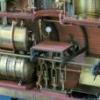
.jpg.d84ec4dad1d7791e855dca06210ab6f3.thumb.jpg.f45209242e851d4409eca1a09293165b.jpg)




